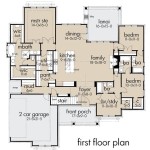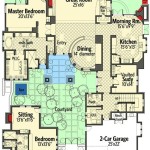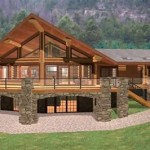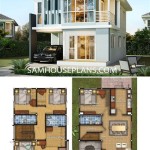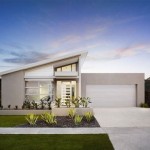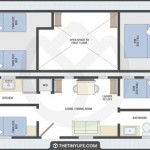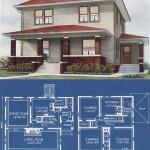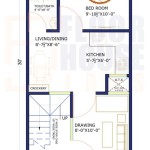Open Floor Plan Home Designs: A Comprehensive Overview
Open floor plan home designs have become increasingly popular in recent years, transforming the way people experience their living spaces. This design concept emphasizes the elimination of traditional walls and barriers between key areas like the living room, dining room, and kitchen, creating a unified and expansive environment. This article explores the defining characteristics, benefits, potential challenges, and design considerations associated with open floor plan layouts.
The core principle of an open floor plan revolves around fostering a sense of connectivity and flow. By removing physical obstructions, these designs aim to enhance the feeling of spaciousness and promote interaction among occupants. This approach contrasts sharply with traditional layouts that prioritize compartmentalization and designated rooms with distinct purposes.
Enhanced Social Interaction and Family Connectivity
One of the primary advantages attributed to open floor plans is their positive impact on social interaction and family connectivity. With fewer walls separating different living areas, individuals can more easily engage with one another, even while performing different activities. For example, a parent preparing a meal in the kitchen can readily supervise children playing in the living room or participate in conversations with guests seated in the dining area. This increased visibility and accessibility can contribute to a more cohesive and interactive family environment.
The open design also facilitates seamless entertaining. Hosts can effortlessly interact with guests while simultaneously preparing food and drinks, ensuring that no one feels isolated or excluded. The expansive nature of the space allows for larger gatherings and provides ample room for mingling and movement.
Furthermore, open floor plans can be particularly beneficial for families with young children. The ability to maintain visual contact with children throughout the primary living areas provides parents with peace of mind and allows for closer supervision. This can be especially advantageous during playtime, meal preparation, or other activities that require parental attention.
Increased Natural Light and Spaciousness
Open floor plans often maximize the influx of natural light throughout the home. Without interior walls obstructing the path of sunlight, light can penetrate deeper into the living space, creating a brighter and more inviting atmosphere. This increased natural light can contribute to improved mood, reduced reliance on artificial lighting, and potential energy savings.
The absence of walls also contributes significantly to the perception of spaciousness. The visual continuity between different areas creates a sense of openness and freedom, making the home feel larger and more airy. This can be particularly appealing in smaller homes where maximizing space utilization is crucial.
Moreover, the open design allows for greater flexibility in furniture arrangement and décor. With fewer physical constraints, homeowners have more freedom to experiment with different layouts and create a living space that reflects their personal style and preferences. This adaptability can be especially valuable over time as families grow and their needs evolve.
Design Considerations and Potential Challenges
While open floor plans offer numerous benefits, it is essential to consider potential challenges and design carefully to avoid common pitfalls. One of the main issues is the lack of privacy. With fewer walls, sound and activity can easily travel between different areas, potentially disrupting those seeking quiet or solitude.
To address this concern, strategic zoning techniques can be employed. This involves using furniture, rugs, or changes in flooring to visually define different areas within the open space without completely enclosing them. For example, a large area rug can delineate the living room area, while a kitchen island can serve as a visual barrier between the kitchen and dining area.
Another challenge associated with open floor plans is the potential for noise pollution. Sound can reverberate easily in the absence of walls, creating an echoey and uncomfortable environment. To mitigate this, incorporating sound-absorbing materials such as upholstered furniture, curtains, and acoustic panels becomes vital. These materials can help dampen sound and reduce echoes, creating a more pleasant and acoustically balanced living space.
Furthermore, maintaining a sense of order and cleanliness in an open floor plan is crucial. Because the space is visually connected, clutter and disorganization can become more apparent and negatively impact the overall aesthetic. Implementing effective storage solutions and establishing regular cleaning routines is essential for maintaining a harmonious and inviting environment.
Heating and cooling can also present challenges in open floor plans. With fewer walls to contain temperature, it can be more difficult to regulate the temperature evenly throughout the space. Consider investing in a zoned HVAC system or using ceiling fans to circulate air effectively. The placement of windows and doors should also be carefully considered to minimize drafts and maximize energy efficiency.
Finally, defining distinct functional zones within the open floor plan is essential for creating a cohesive and practical living space. Clear pathways and well-defined areas for cooking, dining, relaxing, and entertaining will ensure that the space feels organized and purposeful. This can be achieved through the strategic use of furniture, lighting, and décor.
Careful planning and attention to detail are crucial for creating a successful open floor plan home. Working with an architect or interior designer can be beneficial in navigating the design process and ensuring that the space meets the specific needs and preferences of the homeowner.
The selection of materials and finishes also plays a crucial role in the overall aesthetic and functionality of an open floor plan. Choosing cohesive flooring materials throughout the space can create a sense of visual continuity, while contrasting materials can be used to define different zones. Similarly, selecting a consistent color palette and style of décor can help tie the different areas together and create a harmonious look.
Lighting design is another important consideration. Incorporating a variety of lighting sources, including ambient, task, and accent lighting, can help create a warm and inviting atmosphere and enhance the functionality of different areas within the open space. Dimmable lighting fixtures can also be used to adjust the light level according to the time of day and the specific activity taking place.
The placement of windows and doors should be carefully considered to maximize natural light and ventilation. Large windows and sliding glass doors can help bring the outdoors in and create a seamless connection between the interior and exterior spaces. Skylights can also be used to bring natural light into areas that are not directly adjacent to exterior walls.
Ultimately, the success of an open floor plan home design depends on careful planning, attention to detail, and a clear understanding of the homeowner's needs and preferences. By addressing potential challenges and incorporating thoughtful design solutions, it is possible to create a living space that is both aesthetically pleasing and highly functional.
The evolving trends in open floor plans also merit consideration. Modern designs often incorporate elements of flexibility and adaptability, allowing homeowners to reconfigure their living space as needed. Movable partitions, folding screens, and modular furniture can be used to create temporary walls or define different zones depending on the occasion. This trend reflects a growing desire for homes that can easily adapt to changing lifestyles and needs.

House Design Trends What S Popular In Cur Floor Plans Extra Space Storage

Pros And Cons Of An Open Concept Floor Plan Generation Homes Nw

Open Floor Plans Build A Home With Smart Layout Blog Dreamhomesource Com

Pros And Cons Of Open Concept Floor Plans

Open Floor Plans Creating A Breathable Livable Custom Home Builders Schumacher Homes

Why Open Concept Floor Plans Because They Work

5 Advantages Of An Open Floorplan In A Modular Home Next

9 Best Open Floor Plans For Ranch Style Homes Deepnot Log Home House

What S The Deal With Open Floor Plans Whitmore Homes

10 Small House Plans With Open Floor Blog Homeplans Com

